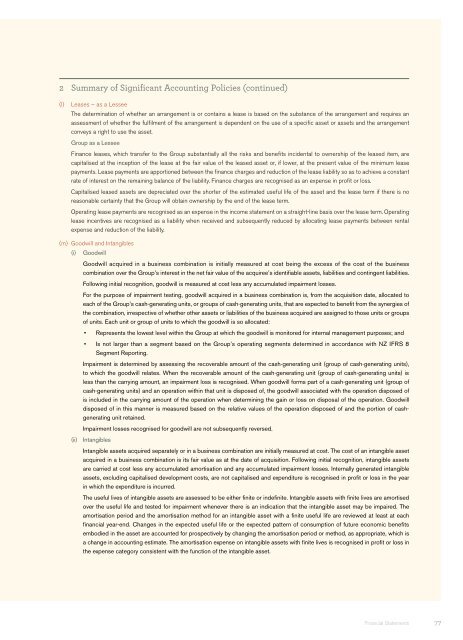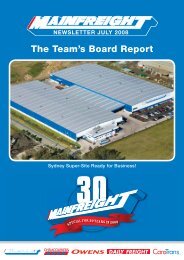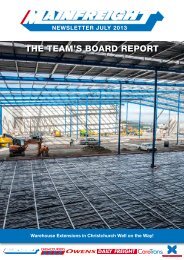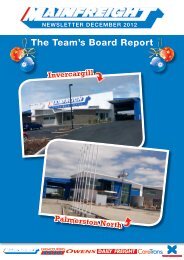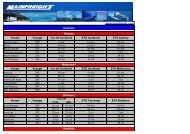Annual Report 2013 - Mainfreight
Annual Report 2013 - Mainfreight
Annual Report 2013 - Mainfreight
You also want an ePaper? Increase the reach of your titles
YUMPU automatically turns print PDFs into web optimized ePapers that Google loves.
2 Summary of Significant Accounting Policies (continued)<br />
(l)<br />
Leases – as a Lessee<br />
The determination of whether an arrangement is or contains a lease is based on the substance of the arrangement and requires an<br />
assessment of whether the fulfilment of the arrangement is dependent on the use of a specific asset or assets and the arrangement<br />
conveys a right to use the asset.<br />
Group as a Lessee<br />
Finance leases, which transfer to the Group substantially all the risks and benefits incidental to ownership of the leased item, are<br />
capitalised at the inception of the lease at the fair value of the leased asset or, if lower, at the present value of the minimum lease<br />
payments. Lease payments are apportioned between the finance charges and reduction of the lease liability so as to achieve a constant<br />
rate of interest on the remaining balance of the liability. Finance charges are recognised as an expense in profit or loss.<br />
Capitalised leased assets are depreciated over the shorter of the estimated useful life of the asset and the lease term if there is no<br />
reasonable certainty that the Group will obtain ownership by the end of the lease term.<br />
Operating lease payments are recognised as an expense in the income statement on a straight-line basis over the lease term. Operating<br />
lease incentives are recognised as a liability when received and subsequently reduced by allocating lease payments between rental<br />
expense and reduction of the liability.<br />
(m) Goodwill and Intangibles<br />
(i) Goodwill<br />
Goodwill acquired in a business combination is initially measured at cost being the excess of the cost of the business<br />
combination over the Group’s interest in the net fair value of the acquiree’s identifiable assets, liabilities and contingent liabilities.<br />
Following initial recognition, goodwill is measured at cost less any accumulated impairment losses.<br />
For the purpose of impairment testing, goodwill acquired in a business combination is, from the acquisition date, allocated to<br />
each of the Group’s cash-generating units, or groups of cash-generating units, that are expected to benefit from the synergies of<br />
the combination, irrespective of whether other assets or liabilities of the business acquired are assigned to those units or groups<br />
of units. Each unit or group of units to which the goodwill is so allocated:<br />
• Represents the lowest level within the Group at which the goodwill is monitored for internal management purposes; and<br />
• Is not larger than a segment based on the Group’s operating segments determined in accordance with NZ IFRS 8<br />
Segment <strong>Report</strong>ing.<br />
Impairment is determined by assessing the recoverable amount of the cash-generating unit (group of cash-generating units),<br />
to which the goodwill relates. When the recoverable amount of the cash-generating unit (group of cash-generating units) is<br />
less than the carrying amount, an impairment loss is recognised. When goodwill forms part of a cash-generating unit (group of<br />
cash-generating units) and an operation within that unit is disposed of, the goodwill associated with the operation disposed of<br />
is included in the carrying amount of the operation when determining the gain or loss on disposal of the operation. Goodwill<br />
disposed of in this manner is measured based on the relative values of the operation disposed of and the portion of cashgenerating<br />
unit retained.<br />
Impairment losses recognised for goodwill are not subsequently reversed.<br />
(ii) Intangibles<br />
Intangible assets acquired separately or in a business combination are initially measured at cost. The cost of an intangible asset<br />
acquired in a business combination is its fair value as at the date of acquisition. Following initial recognition, intangible assets<br />
are carried at cost less any accumulated amortisation and any accumulated impairment losses. Internally generated intangible<br />
assets, excluding capitalised development costs, are not capitalised and expenditure is recognised in profit or loss in the year<br />
in which the expenditure is incurred.<br />
The useful lives of intangible assets are assessed to be either finite or indefinite. Intangible assets with finite lives are amortised<br />
over the useful life and tested for impairment whenever there is an indication that the intangible asset may be impaired. The<br />
amortisation period and the amortisation method for an intangible asset with a finite useful life are reviewed at least at each<br />
financial year‐end. Changes in the expected useful life or the expected pattern of consumption of future economic benefits<br />
embodied in the asset are accounted for prospectively by changing the amortisation period or method, as appropriate, which is<br />
a change in accounting estimate. The amortisation expense on intangible assets with finite lives is recognised in profit or loss in<br />
the expense category consistent with the function of the intangible asset.<br />
Financial Statements<br />
77


